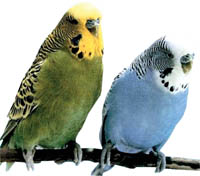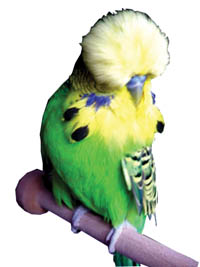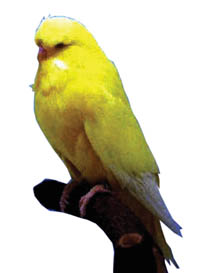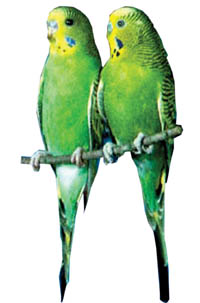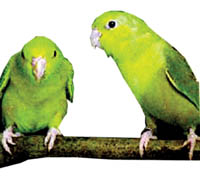|
observer |
|
|
|
|
|
OTHER LINKS |

|

|

|
|
|
|
|
Budgerigars, the most popular cage birds, nicknamed 'budgies' have been bred in captivity since the 1850s. Often called parakeets, especially in American English, the budgies belong to the tribe of broad - tailed parrots. In fact, a number of small parrots with long, flat tails are often referred to as parakeets.
The budgies are the only species in the Australian genus Melopsittacus. The genus name Melopsittacus comes from the Greek word which means 'Melodious parrot' and the species name, undulatus is Latin for 'undulatus' or 'wave-patterned'.
Even though these birds were bred for captivity only in the early 1800s, they have been living in the inland drier parts of Australia for over five million years.
Budgerigars are excellent pets because they are cute little birds who are intelligent, active and sociable. They enjoy a lot of stimulation and will welcome a lot of toys to keep them active when reared as pets.
They interact well with humans and other budgies. If you want to keep your pet budgies happy, make sure they have enough things in their cages to keep them busy, doing something all the time.
|
|
However, be wary of these busybodies whose common, negative behaviour will be chewing up things especially made of wood. So, don't leave things you treasure near them to destroy.
Both male and female birds can sing and mimic though this talent is more pronounced in males. They can be taught to speak, whistle tunes and play with humans. However, keep in mind that the budgies, unlike the cockatoos or lovebirds, have very tiny voices which arn't very audible (cannot be heard). One has to listen very carefully to hear their voices. As pets, they'll keep you amused for hours with their cute antics and affectionate behaviour.
The budgies are known to live upto 5 - 8 years or more in captivity, especially if they are well cared for.
Food, habits and habitats
Budgerigars in the wild are nomadic birds found especially in open habitats principally in Australian scrublands, grasslands and open woodlands.
|
|
They usually live in small flocks, but can be found in large flocks, especially if there is an abundance of food and water.
Budgies have the habit of nesting in not only holes in trees, but also in fence posts, or even logs on the ground. The females lay around 4-5 eggs per clutch, which hatch in 10-20 days, at two-day intervals.
The chicks get their down feathers in a week and permanent feathers in 3-4 weeks. The birdlings generally leave the nest in 4-5 weeks' time. The budgies eat mostly seeds, grassweeds and sometimes ripening wheat.
Appearance
No more than 18 cm long and weighing around 30-40 grams, wild budgerigars generally are green in colour. They have green underparts and rumps. The underparts are lined with yellow and black.
Forehead and face is yellow in adults and lined with black and yellow feathers in the young birds. Once they mature they change to adult plumage.
|
|
The birds have small, dark purple patches on each cheek and a series of black specks, that form sort of a necklace around the throats. The tails are a greenish- purple or purple outside. The tail and feet have a central yellow band.
The wings which are mostly greenish have black flight feathers and black coverts with a yellow fringe. The beaks or bills are olive-grey and the legs are greyish-blue. The wild birds are generally smaller than those bred in captivity.
Many breeders have worked over a long period to introduce feather mutations and a range of colours such as yellow, white, blue, violet, olive and lutino (yellow). They have bred two varieties; the English budgerigar which is the popular show bird seen at exhibitions and is rather larger, and the Australian (or American parakeet) that comes in a variety of colours and is smaller than the English show bird.
The male and female birds have different coloured ceres (area outside nostrils). In male-birds the ceres is generally royal blue, while in non-breeding females, it is pale brown to white, and brown in breeding female birds.
It is pinkish in colour in both male and female birds who are not mature.
Don't you think budgerigars are cute feathered friends that should be treasured?
Now let's look at yet another member of the fascinating family of parrots, parrotlets.
|
|
Considered to be the smallest members, parrotlets are fiesty little birds that are nothing more than five inches in length and weighing less than 30 grams. They are primarily green in colour with patches of yellow, grey and blue differentiating their gender, species and sub-species.
Parrotlets have short, wedge- shaped tails and beaks which are rather large in comparison to the size of their bodies. Relatively new to the pet-trade, the most popular species of parrotlets are the Pacific, Mexican and the Green-rumped. Many beautiful mutations, especially of the Pacific parrotlet have been introduced in blue, dark blue, yellow, cinnamon, lutino, albino, white, dark green and blue-fallow.
Even though these birds are really small, they are fiesty and courageous birds. Because they are related to the larger Amazon species of parrots, and are fearless by nature, many call them the 'Amazons in pint-sized bodies.'
|
|
These new world parrots live in flocks, which can range from just four birds upto a hundred, in the wild.
They make wonderful pets because they are not very noisy, are playful and enjoy human interaction. Even though they have a limited ability to speak, when compared to other species in this family of birds, parrotlets can be taught to speak several words and a few phrases, and make many sounds and whistle too.
However, as they have very low voices, one needs to listen carefully to distinguish (make out) these sounds from their normal sounds, which are usually pleasant chirps.
Parrotlets live long, even up to 10 years or more when well cared for. So, if you have any budgies or parrotlets as pets, make sure you take good care of them and have them around for a long, long time.
Fact File
* At least 32 colour mutations of budgies are recorded, enabling hundreds of possible sub mutation.
* English budgerigars have puffy head feathers which obscure (conceal) the bird's eyes and beak. These birds are larger than their wild cousins.
* The lifespan of budgerigars depends on the breed.
* Some of the rare species of parrotlets are Blue Wing, Yellow Face and Sclater's parrotlets.
* The Green Rumped is the smallest, weighing no more than 22 grams and is native to Guyana.
* The rarest parrotlet, the Yellow Face is found only in remote valleys in Peru.

